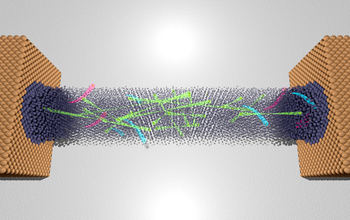Multimedia Gallery
Uncovering why nanomaterial loses superconductivity
An illustration that describes Adrian Del Maestro's, associate professor at the University of Vermont, pair-breaking critical theory in nanowires. Electrons inside an ultra-thin MoGe wire with a radius on the order of 10 nanometers can pair up at low temperatures (green) and travel from one contact to the other without resistance in the superconducting phase. In the presence of a magnetic field penetrating the wire, the members of the pairs are deflected in opposite directions (pink and blue) and may collide with the edges of the wire and break apart. As the strength of the field is increased, all pairs break, and the nanowire undergoes a zero temperature phase transition from a superconductor to a normal metal. At the transition, the conductivity of the wire is a universal number that does not depend on any specific details of the wire composition or field direction.
More about this image
A group of physicists, led by University of Utah (U) professor Andrey Rogachev, has discovered that superconducting nanowires made of MoGe alloy undergo quantum phase transitions (QPT) from a superconducting to a normal metal state when placed in an increasing magnetic field at low temperatures. The study is the first to uncover the microscopic process by which the material loses its superconductivity.
The findings are fully explained by the critical theory proposed by coauthor Adrian Del Maestro, associate professor at the University of Vermont. The theory correctly described how the evolution of superconductivity depends on critical temperature, magnetic field magnitude and orientation, nanowire cross sectional area, and the microscopic characteristics of the nanowire material. This is the first time in the field of superconductivity that all details of QPT predicted by a theory were confirmed on real objects in the lab.
"Quantum phase transitions may sound really exotic, but they are observed in many systems, from the center of stars to the nucleus of atoms, and from magnets to insulators," said Rogachev, associate professor at the U and senior author of the study. "By understanding quantum fluctuations in this simpler system, we can talk about every detail of the microscopic process and apply it to more complicated objects."
This research was supported in part by the National Science Foundation (grants DMR 16-11421 and DMR 15-53991). Adrian Del Maestro performed a portion of this work at the Aspen Center for Physics, which is supported by NSF (grant PHY 16-07611).
Learn more in the NSF News From the Field story Physicists uncover why nanomaterial loses superconductivity. (Date image taken: June 19, 2018; date originally posted to NSF Multimedia Gallery: Dec. 17, 2018)
Credit: Adrian Del Maestro
Images and other media in the National Science Foundation Multimedia Gallery are available for use in print and electronic material by NSF employees, members of the media, university staff, teachers and the general public. All media in the gallery are intended for personal, educational and nonprofit/non-commercial use only.
Images credited to the National Science Foundation, a federal agency, are in the public domain. The images were created by employees of the United States Government as part of their official duties or prepared by contractors as "works for hire" for NSF. You may freely use NSF-credited images and, at your discretion, credit NSF with a "Courtesy: National Science Foundation" notation.
Additional information about general usage can be found in Conditions.
Also Available:
Download the high-resolution JPG version of the image. (4.8 MB)
Use your mouse to right-click (Mac users may need to Ctrl-click) the link above and choose the option that will save the file or target to your computer.



